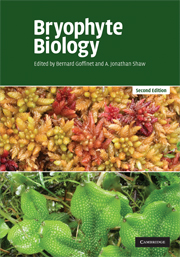Book contents
- Frontmatter
- Contents
- List of contributors
- Preface
- 1 Morphology and classification of the Marchantiophyta
- 2 Morphology, anatomy, and classification of the Bryophyta
- 3 New insights into morphology, anatomy, and systematics of hornworts
- 4 Phylogenomics and early land plant evolution
- 5 Mosses as model organisms for developmental, cellular, and molecular biology
- 6 Physiological ecology
- 7 Biochemical and molecular mechanisms of desiccation tolerance in bryophytes
- 8 Mineral nutrition and substratum ecology
- 9 The structure and function of bryophyte-dominated peatlands
- 10 Population and community ecology of bryophytes
- 11 Bryophyte species and speciation
- 12 Conservation biology of bryophytes
- Index
- References
3 - New insights into morphology, anatomy, and systematics of hornworts
Published online by Cambridge University Press: 06 July 2010
- Frontmatter
- Contents
- List of contributors
- Preface
- 1 Morphology and classification of the Marchantiophyta
- 2 Morphology, anatomy, and classification of the Bryophyta
- 3 New insights into morphology, anatomy, and systematics of hornworts
- 4 Phylogenomics and early land plant evolution
- 5 Mosses as model organisms for developmental, cellular, and molecular biology
- 6 Physiological ecology
- 7 Biochemical and molecular mechanisms of desiccation tolerance in bryophytes
- 8 Mineral nutrition and substratum ecology
- 9 The structure and function of bryophyte-dominated peatlands
- 10 Population and community ecology of bryophytes
- 11 Bryophyte species and speciation
- 12 Conservation biology of bryophytes
- Index
- References
Summary
Introduction
Hornworts are a key lineage in unraveling the early diversification of land plants. An emerging, albeit surprising, consensus based on recent molecular phylogenies is that hornworts are the closest extant relatives of tracheophytes (Qiu et al. 2006). Prior to comprehensive molecular analyses, discrepant hypotheses positioned hornworts as either sister to all embryophytes except liverworts or the closest living relatives of green algae (Mishler et al. 1994, Qiu et al. 1998, Goffinet 2000, Renzaglia & Vaughn 2000). Morphological features are of little value in resolving the placement of hornworts within the green tree of life because this homogeneous group of approximately 150 species exhibits numerous developmental and structural peculiarities not found in any extant or fossil archegoniate. Until recently, hornworts were neglected at every level of study and thus even the diversity and the relationships within this group have remained obscure.
Virtually every aspect of hornwort evolution has been challenged and/or revised since the publication of the first edition of this book (Duff et al. 2004, 2007, Shaw & Renzaglia 2004, Cargill et al. 2005, Renzaglia et al. 2007). Phylogenetic hypotheses based on multigene sequences have revolutionized our concepts of interrelationships. New classification schemes have arisen from these analyses and continue to be fine-tuned as more taxa are sampled. Three new genera have been named, increasing the number of hornwort genera to 14, namely Leiosporoceros, Anthoceros, Sphaerosporoceros, Folioceros, Hattorioceros, Mesoceros, Paraphymatoceros, Notothylas, Phaeoceros, Phymatoceros, Phaeomegaceros, Megaceros, Dendroceros, and Nothoceros (Duff et al. 2007, Stotler et al. 2005).
- Type
- Chapter
- Information
- Bryophyte Biology , pp. 139 - 172Publisher: Cambridge University PressPrint publication year: 2008
References
- 11
- Cited by



